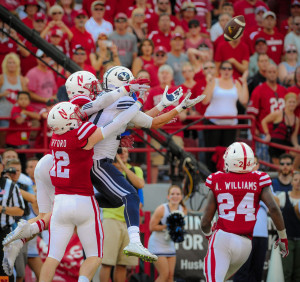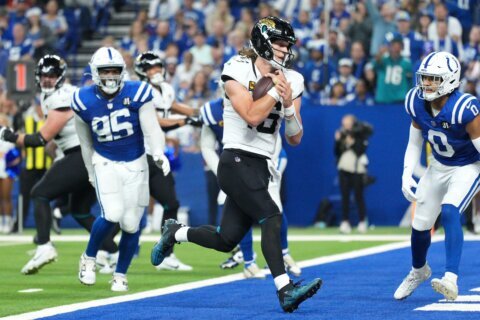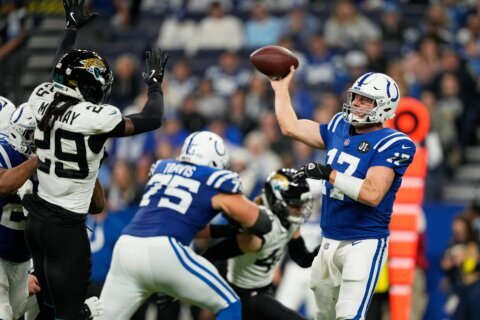WASHINGTON — We’re two weeks into the college football season and one week into the NFL campaign. And while there has been plenty of drama, close games and blowouts, we’ve already had two absolutely brutal displays of game management by two of the most experienced coaches in the sport, begging the question: How is it that veteran coaches being paid seven figure salaries to win football games do not understand the basic tenets of win probability?
On Sunday night, the New York Giants led the Dallas Cowboys on the road in Texas, 23-20, driving deep into opposition territory as the clock wound down, no timeouts left for Dallas. The Giants found themselves facing a third and goal from the 1-yard line with 1:43 remaining, at which point Eli Manning ran a play-action pass, on which he couldn’t find an open receiver, simply firing the ball out the back of the end zone. Then, on fourth and goal, coach Tom Coughlin elected to kick a field goal to put the Giants up by six. That left the Cowboys with 94 seconds to score the game-winning touchdown, which they dutifully did, winning 27-26.
Many have questioned Coughlin’s decision to throw the ball on third down, where a run play, if stopped short, would at least wind the clock. But there isn’t a problem with the play itself, if you think it gives you your best shot to score, and therefore win the game. The problem comes only with what happens if the play is not available, as it wasn’t Sunday night.
“Well Bob, that was absolutely baffling to me,” said former Indianapolis Colts head coach Tony Dungy in the postgame analysis, who did not dispute the play call. “You have to tell (Manning), when you send the play in, to take the sack.”
At that point, if you were planning on simply kicking the field goal on fourth down (not the right call, but more on that later), then Manning simply cannot throw the ball away. He has to be told, as Dungy explained, to take a sack, which would not make the field goal demonstrably longer, but would ensure a full 40 seconds ticked off the clock, cutting about 40 percent of Dallas’ time to run their ensuing drive.
Both Coughlin and Manning acknowledged as much after the game. Still, that should never have been a consideration, as kicking a field goal is simply not the right call according to the odds, especially one that leaves the contest a one possession game.
“You have to,” said color commentator Cris Collinsworth quite incorrectly about the Giants electing to kick the field goal.
But here’s the thing — sitting at fourth and goal on the one-yard line, you stand a pretty good chance of scoring the touchdown anyway, which again, wins the game right there, for all intents and purposes.
University of California, Berkeley professor David Romer conducted a comprehensive analysis using three years of NFL data to determine the values between going for it and not in fourth down situations. Romer’s comprehensive work, which he details in a 30-page dissertation, may be dense for those not versed in mathematics, but his findings were pretty straightforward.
A team within 5 yards of the end zone is better off going for the touchdown than the field goal.
By using first quarter data, removing end-of-half and end-of-game situations, Romer ensured that his findings apply to any situation, regardless of specific in-game leverage. But the math supports going for the touchdown in Coughlin’s situation even more, as a touchdown doesn’t simply put them ahead by two scores, it does so with a nearly impossibly small amount of time left for the Cowboys to score, recover an onside kick and score again.
In one specific example, Romer highlights the chances of success at fourth and goal from the two-yard line at roughly 42 percent. At fourth and goal from the 1, those odds are even higher. Even if the play fails, it leaves Dallas with the entire field to traverse, as opposed to kicking them the ball after the field goal, giving them a chance to potentially break a big return, and likely allowing them to start their drive at the 20-yard line or better.
While the field goal forces Dallas to score 7 points instead of simply 3 to force overtime, that is its only advantage. If you fail to convert the fourth down attempt, then Dallas drives and only scores the field goal, at least you go to overtime with a roughly 50 percent chance to win, rather than losing the game outright.

Two weekends ago, BYU shocked Nebraska on a Hail Mary pass at the buzzer. But much like the Cowboys, the Cougars should never have even had the chance to throw their game-winning pass, much less time to diagram it.
Nebraska had the lead and the ball leading 28-27, driving into BYU territory. On third and 3 from the 22, the Cornhuskers ran a draw play that lost two yards, setting up a fourth and 5 at the 24 with 54 seconds remaining and BYU out of timeouts. In a situation where a first down would have won the game, Riley instead attempted a 41-yard field goal by Drew Brown (who had already missed a 40-yarder earlier and is just 3-for-8 on kicks from 40-49 yards in his college career) which would have only put his team ahead by four points. Brown missed, leaving the Cougars with 48 seconds to get in position to score.
With six seconds to play, Riley inexplicably used one of his two remaining timeouts, allowing BYU to set up a play. After an incomplete pass, with one second left, Riley used his final timeout, allowing the Cougars again to regroup, after which Tanner Mangum hit Mitch Mathews with a 42-yard, game-winning pass as time expired.
While the timeouts were bad, the whole affair would have been much less likely to transpire if Riley had simply made the decision to go for the first down.
Perhaps what’s most maddening about both these late-game mismanagements is that they’ve been bungled by two of the most veteran coaches in the sport. Riley has been coaching since 1975, with nearly 200 college games under his belt as a head coach in addition to nearly 50 as an NFL head coach. Coughlin had been in the game since 1969, and has held the Giants job since 2004, an eternity in the NFL. Perhaps that’s the very reason that both cling to the conventional wisdom of kicking in situations where going for it is the right decision.
Both coaches made crucial mistakes late in their respective games, but they have been criticized much more loudly for the wrong incorrect decisions. It’s the lack of willingness to go for it on fourth down, rather than kick, that had a greater role in defining the outcome of each game.
“That is just crazy,” said Al Michaels as Jason Witten caught Tony Romo’s pass for the game-winning score for Dallas Sunday night.
The only thing crazy was the poor decision that ever allowed it to happen in the first place.







